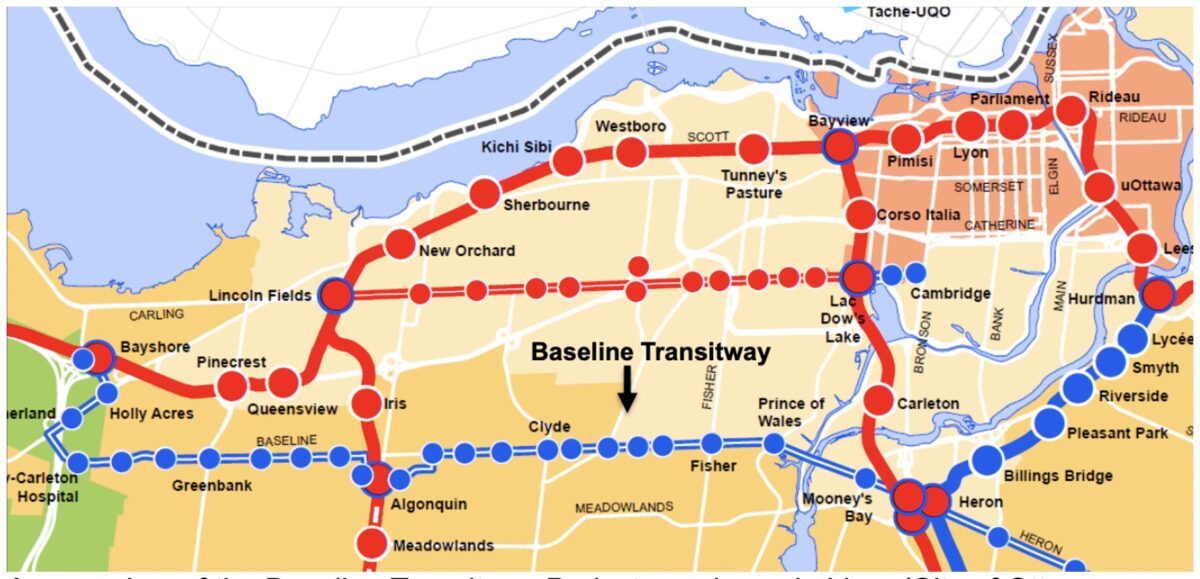The City of Ottawa is moving forward a 14-kilometre rapid bus transit corridor designed to revolutionize sustainable transportation between Bayshore and Heron stations.
The first of three phases in the Baseline Transitway Project is to begin construction in spring 2025.
This first stage will focus on the reconstruction of the Greenbank Road and Baseline Road intersection, introducing bus priority lanes, new concrete sidewalks and curbs, raised asphalt cycle tracks and reconfigured traffic lanes.
City documents say the $18.5-million first phase aims to improve safety and OC Transpo service.
The city is expropriating some properties, a plan documented in a recent staff report presented to the Finance and Corporate Services Committee, which outlined the necessity of land acquisition for the first phase of the project.
The Baseline corridor has high transit ridership, exceeding pre-pandemic levels. It serves as a vital east-west link connecting major destinations such as Algonquin College and Confederation Heights, a complex of federal government offices south of Carleton University.

A key component of the first phase is the inclusion of protected cycling infrastructure to separate cyclists from vehicles with barriers. In general, the percentage of trips where bicycles were used as a primary mode of transportation has more than doubled from 1.9 per cent to 3.9 per cent between 2011 and 2022, according to the city’s 2024 Transportation Trends Report.
Guillaume Gaillard, chair of the advocacy working group for pro-cycling organization Bike Ottawa, said commuters and people that cycle “are quite eager to see it happen.”
Designs for the first phase of construction show the cycle tracks as 1.8 metres wide, which Gaillard called an improvement from earlier designs. Previously, a narrow one-metre strip between the vehicle lane and the bike lane raised concerns about snow piling up onto the lane during winter.
Gaillard said he hopes the project will lead to better connections between neighborhoods, encouraging more people outside downtown to feel comfortable cycling.
If you make one bit safe and then the next you do nothing, well, it does nothing for people who are not comfortable enough to ride with the traffic.
— Guillaume Gaillard, advocacy chair, Bike Ottawa,
He said there is a need for a continuous separated route to make cycling a viable option for more people.
“If you make one bit safe and then the next you do nothing, well, it does nothing for people who are not comfortable enough to ride with the traffic,” Gaillard said.
Hans Moor, former president of Bike Ottawa, was also enthused. “I was really happy to see that they decided to put in protected intersections,” he said.
According to the city’s Protected Intersection Design Guide, a protected intersection aims to improve safety for vulnerable users including cyclists and pedestrians at intersections. This includes shortening crossing distances, reducing pedestrian exposure to traffic, increasing their visibility to drivers and improving yielding behaviour by drivers.
Moor said he believes this “mega project” has the potential to be a “game changer” for cycling in Ottawa. He said he envisions it facilitating network connections to key destinations.
However, Moor stressed the importance of proper design, especially at intersections, to ensure cyclist safety with turning traffic.
William van Geest, executive director at Ecology Ottawa, described the project as “long overdue” given the need for a shift to sustainable transportation.

Like Gaillard, van Geest also noted that while separated infrastructure is a step forward, the proposed width for cycle tracks felt insufficient, especially when compared to the space allocated for vehicle lanes.
“It’s just such a clear illustration,” he said, “of where the city’s priorities are — and those priorities are not people who are outside of cars.”
You build more bike infrastructure, and more people start to bike — and that’s really cool to see.
— Hans Moor, Ottawa cycling advocate and blogger
While welcoming the separated cycle tracks and protected intersection in phase one, van Geest criticized the city’s “piecemeal approach” to cycling infrastructure, pointing out that the initial phase provides a limited stretch of safe cycling not yet connected to a broader network.
He highlighted the need for an “all ages, all abilities” approach to design, questioning whether the facilities would be safe and comfortable for children and seniors.
Despite varying perspectives on the immediate impact and design specifics, there is a general consensus among advocates that the project represents a step towards improving sustainable transportation in Ottawa.
As Moor put it, “you build more bike infrastructure, and more people start to bike — and that’s really cool to see.”





Regarding the Baseline RT, I note that cars are still given the same number of lanes which does not encourage a switch to public transit. Also, since there are seldom any pedestrians at most times, why can’t the cyclists and pedestrians share a multi-use path which would eliminate the concern about snow build-up and might reduce the need for expropriation of property fronts which would reduce values of the housing along the route.